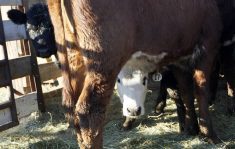ROCKY MOUNTAIN HOUSE, Alta. – Every year Kim Nielsen swath grazes, he learns something different.
On his 4 Clover Ranch near Rocky Mountain House, Alta., he has learned to keep records so adjustments can be made each year.
“The crop this year is not panning out as I had intended,” he told a cattle producers’ day at his ranch.
For starters, he received the wrong seed mix in the spring. He asked for a mix of 35 bushels of fall rye and 25 bushels of oats. He ended up with more fall rye than he wanted. The nutrient value is good, but the yield is not as high as he wanted.
Read Also

Global meat packer prepares for cattle shortage
Brazilian meat packer JBS is preparing for a likely shift in the country’s cattle cycle that could lead to reduced availability of animals for slaughter next year.
The fall rye regrowth will be grazed in the spring.
He preferred Waldron or Baler oats in a mix with Musketeer rye.
“There is a lot of difference in varieties and what the cows like to eat.”
The crop was seeded at the end of June and swathed at the end of September. He cuts it before the heads start filling so there is no problem with shattering.
A standby source of feed is kept if weather is too bad or the snow has crusted over and the cows cannot dig through.
The swaths should be tested and it is important to watch for grass tetany. If the calcium-phosphorus ratio is out of proportion to sodium, the cows may sicken.
Nielsen offers free-choice minerals to ensure they get enough calcium.
“It is difficult to get the (right) amount of calcium into them but in all the years we have never had a downer cow or had issues with grass tetany,” he said.
If using the same field each year, the feed should be tested. Manure and urine being dropped on the field change the soil and plant quality.
Wildlife entering the fields could be a problem, especially in dry years when there is no forage in pastures.
“You will be attracting some wildlife and if you are in an area where there is elk, you can have some problems.”
Nielsen has noticed manure from white-tailed deer in the swaths, but this does not harm the feed the way elk droppings do.
Fences required
To make swath grazing work, a proper electric fencing system is necessary, said Doug Bidulock, an Innisfail, Alta., producer who sells and installs electric fences.
Each farm is different and may require a unique system. The main thing is to make sure cattle learn to respect the fence and do not challenge it.
“It is a psychological barrier. We want it to shock that animal on the front part of the face,” Bidulock said.
Electric fences need sufficient voltage on the fence line so the shock penetrates the animal’s skin.
A live ground return system works well with a ground rod every kilometre to help bring the signal back through the soil.
Proper grounding is critical to making an electric fence work. Fences often fail because they were not grounded properly. Soil conducts better when it is moist. Dry air and dry ground may result in resistance.
“Ninety percent of the problems we have actually come back due to the ground rods, rusty ground rods or not enough grounds for the size of energizer you have,” said Bidulock.
The high insulating factor of snow and frost restricts a fence’s ability to deliver a shock. To overcome this, build a two wire fence where one wire is hot. Position the non-hot wire and hot wire about 30 centimetres apart so when the animal touches both wires it feels the maximum shock.
“You want to make sure that those electrons flow through the circle so when that animal puts her nose on that fence, she is taking the full hit,” he said.















